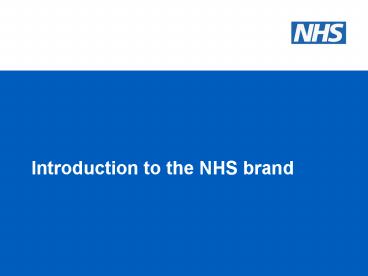Introduction to the NHS brand - PowerPoint PPT Presentation
1 / 24
Title:
Introduction to the NHS brand
Description:
Use logotypes in their original blue and black, solid black or white only. Each NHS organisation is issued with its own logotype free of charge ... – PowerPoint PPT presentation
Number of Views:28
Avg rating:3.0/5.0
Title: Introduction to the NHS brand
1
Introduction to the NHS brand
2
What does this presentation cover?
- Background to the NHS brand - and why it is
important - Getting it right an overview of the corporate
identity guidelines - Further information and support
3
Background to the NHS brand
- Single corporate identity introduced 1998/99
- Corporate identity reflecting national policy
- move from internal market to one NHS
- Local desire for clarification around identity
- moving on from logo soup
- Making services visible
- clarifying what is or is not an NHS service
4
The power of the brand
- Over 90 unprompted recognition of NHS identity
- Very high levels of trust and integrity
- Trusted as a credible and impartial deliverer of
health services and health information - Has the ability to arrest and inform
- Compiled from MORI research
5
The NHS is changing
- Services are being delivered in new ways by
different organisations - NHS is becoming more patient led more
personalised services with choices for patients - We need to help the public navigate this more
diverse healthcare system
The NHS brand plays a crucial role in doing this
6
The role of the brand
- The NHS brand can help and reassure the public by
- signposting accountability
- easing access
- communicating values
- It is critical that the NHS brand identity is
used consistently and prominently to achieve this
7
Consistent use of the NHS brand
8
Getting it right -An overview of the
corporate identity guidelines
9
The NHS brand
Products
Logo
All NHS services, information and advice/support
Comms principles
Modern Straightforward Professional Caring Respect
ful Honest
Values
Colours
Health Care Professionalism Efficiency
Equality Choice
Design elements
Frutiger font
10
The logo
- Exclusion zone
- Minimum recommended size is 10mm on A4
- Download the logo from the NHS Identity Website
at www.nhs.uk/nhsidentity - The logo is a registered trademark
11
The logo
- Use NHS Blue (Pantone? 300), black or white
reversed out of a colour from the colour palette - Never reproduce as tints
12
Different logotypes for different organisations
- National example
- Local example
- Non-statutory example
- (Non-legal - accountable to
- one or more statutory organisation)
13
Local logotypes
- Use the full and legal name of organisation
(refers back to accountability) - Use logotypes in their original blue and black,
solid black or white only - Each NHS organisation is issued with its own
logotype free of charge - Order new or replacement artwork from the NHS
Identity Helpline on 020 7972 5250
14
No new logos why?
- No new logos to be developed within the NHS as
they - Compete with and compromise the integrity of the
NHS logo. - Do not demonstrate a direct line of
accountability for the information and services
provided - Hold no immediate recognition to the public which
already recognise and trust the NHS logo. - Incur unnecessary costs in their development and
implementation.
15
Positioning of the NHS logo
- Correct position top right
- Secondary position is bottom right
- Logo may only appear once on any communications
including when NHS organisations are working
together
16
Partnership
- When NHS organisations are working together
- Use NHS logo once
- List names or partner organisation elsewhere
- Or use a description such as The NHS in Cumbria
and Lancashire
17
Colour
- Blue is synonymous with the NHS
- NHS Blue (Pantone? 300)
- Secondary colour palette - modern and vibrant
- Large range including tints - 13 colours each
with 9 tints
18
Fonts
- Frutiger should be used on all NHS professionally
printed communications - Use Arial for work produced internally
- You can also use Garamond and Times New Roman
- Minimum size 12 point for accessibility
19
Imagery
- Use of photography is encouraged over
illustration - Consider appropriateness of chosen imagery
- Must reflect our communication principles
- No text over graphics
- Use the newly redeveloped NHS Photo Library
www.nhs.uk/photolibrary
20
Words
- Use plain English
- Our communications principles
- Straightforward
- Clear
- Accessible
- Honest
- Tone of voice appropriate to audience
- Short sentences
21
Corporate vs Marketing material
- Corporate literature such as letterheads,
business cards and compliments slips must follow
strict layout guidelines - www.nhs.uk/nhsidentity
- Marketing and patient information communications
have greater design flexibility - Must still be clearly owned by the NHS and
support NHS values - Develop within the NHS corporate identity
guidelines
22
Creating your own design style
- Create an individual look and feel for products
and initiatives within the NHS identity by using - Colour 14 different colours in the NHS colour
palette - Font different weights and styles of the NHS
typeface Frutiger - Imagery and graphics consistent placement and
style of imagery, thereby creating a design
template - New guidance available The NHS Identity at a
local level Developing a design style for your
organisation
23
Example
24
Further information and support
- NHS Identity Website www.nhs.uk/nhsidentity
- NHS Identity Helpline
- Tel 020 7972 5261 or 020 7972
- Fax 020 7972 1501
- E-mail nhsidentity_at_dh.gsi.gov.uk































